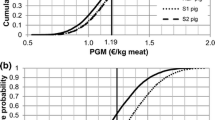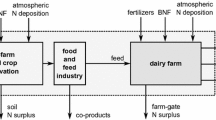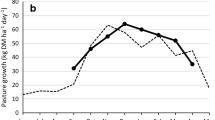Abstract
This study is in two parts. In the first part, nitrogen (N) losses per unit of milk and meat in Danish conventional and organic pig and dairy farming were compared on the basis of farm data. In the second part, organic and conventional dairy farming were compared in detail, using modelling. N-surpluses at different livestock densities, fodder intensities, and soil types were simulated. Finally, simulated N-surpluses were used in national scenarios for conversion to organic dairy farming in Denmark. In Part one, pig farming was found to have a higher N-efficiency than dairy farming. Organic pig production had a lower N-efficiency and a higher N-surplus per kg meat than conventional pig production. The possibilities to reduce N-loss by conversion to organic pig production therefore appear to be poor. Organic dairy farming had a higher N-efficiency and a lower N-surplus per kg milk than conventional dairy farming. Conversion from conventional to organic dairy farming may therefore reduce N-losses. In Part two, a positive correlation between livestock density and N-surplus ha-1 was found for dairy farming. For all simulated livestock densities, fodder feeding intensities and soil types, organic systems showed a lower N-surplus per unit of milk produced than conventional systems. National scenarios for dairy farming showed that the present Danish milk production could be achieved with a 24% lower total N-surplus if converted from intensive conventional farming to extensive organic farming. At the same time, N-surplus ha-1 and N-surplus (t milk)-1 would be lowered by 50% and 25% respectively. Changing from intensive to extensive conventional dairy farming with a livestock density equal to that in the organic scenario resulted in a reduction in N-surplus ha-1 of 15%. It was concluded that a reduction in total N-loss from agriculture is possible by converting from conventional to organic dairy farming but at the cost of either lower production on the present dairy farm area, or the current production on a substantially larger area.
Similar content being viewed by others
References
Aarts HFM, Biewinga EE & van Keulen H (1992) Dairy farming systems based on efficient nutrient management. Neth J Agr Sci 40: 285-99
Alders JGM (1991) Rådets direktiv af 12. december 1991 om beskyttelse af vand mod forureninger forårsaget af nitrater, der stammer fra landbruget. De Europæiske Fællesskabers Tidende 375(91/676/EEC): 1-8
Bendixen I, Jeppesen JH & Krüger A (1997) Atmosfærisk nedfald 1996. Fyns Amt. Odense. 45 p
Bleken MA & Bakken LR (1997) The anthropogenic Nitrogen Cycle in Norway. In: Romstad E, Simonsen J & Vatn A (eds) Controlling Mineral Emissions in European Agriculture. CAB International 2: 27-40
Conway G (1987) The Properties of Agroecosystems. Agr Syst 24: 95-117
Dalgaard T (1997a) Bottom up modelling of scenarios for environmental impact in livestock intensive areas. In: Olesen SE (ed): Alternative Use of Agricultural Land. Paper for NJF-seminar on Alternative Use of Agricultural Land. Danish Institute of Agricultural Sciences. Research Centre Foulum 9-10 June 1997. SP report No. 18
Dalgaard T (1997b) Nitrat-direktivet giver problemer. Jord and Viden 5: 10-12
Dalgaard T, Halberg N & Kristensen, ES (1997) Use of fossil energy in dairy farming. Analysis and simulation of organic and conventional farming. Danish Institute of Agricultural Sciences. Research Centre Foulum. SH Beretning (in press)
Danmarks Statistik (1989) Special extract from Danish Agricultural Statistics. Danmarks Statistik. Copenhagen
Danmarks Statistik (1996) Landbrugsstatistik 1995. Danmarks Statistik. Copenhagen. 294 p
de Wit CT de (1992) Resource Use efficiency in agriculture. Agr Syst 40: 125-51
Doluschitz R, Welck H & Zeddies J (1992) Stickstoffbilanzen landwirtschaftlicher Betriebe -Einstieg in eine ökologische Buchführung? Ber Landwirt 70: 551-65
Ekeberg E & Riley H (1995) The long-term fertilizer trials at Møystad, S.E. Norway. In: Christensen BT, Trentemøller U (eds) The Askov Long-Term Experiments on Animal Manure and Mineral Fertilizers, pp 83-97. Danish Institute of Plant and Soil Science, Research Centre Foulum.
Grundahl L & Hansen, JG (1990) Atmosfærisk nedfald af næringssalte i Danmark. Miljøstyrelsen. Ministry of Environment, Copenhagen. A6: 1–60. NPo-forskning
Halberg N (1996) Resultater fra 2 års afprøvning af etiske regnskaber. Royal Veterinary and Agricultural University, Section for Economy. Copenhagen. 143-178. Miljø-og ressourceindikatorer til brug i et etisk regnskab for husdyrbrug. PhD thesis
Halberg N & Jensen CH (1996) Dairy farm production strategy and nitrogen surplus. In: Walter-Jørgensen A & Pilegaard S (eds) Integrated Environmental and economic Analysis in Agriculture, pp 103-21. Statens Jordbrugs-og fiskeriøkonomiske Institut, Copenhagen. ISBN: 0107-5357
Halberg N & Kristensen IS (1997) Expected crop yield loss when converting to organic dairy farming in Denmark. Biol Agric Hort 14: 25-41
Halberg N, Kristensen ES & Kristensen IS (1995) Nitrogen turnover on organic and conventional mixed farms. J Agric Environ Ethic 8(1): 30-51
Jarvis SC (1993) Nitrogen cycling and losses from dairy farms. Soil use manage 9(3): 99-105
Korevaar H (1992) The nitrogen balance on intensive Dutch dairy farms: a review. Livest Prod Sci 31: 17-27
Kristensen T (1997) Studier i økologiske jordbrugssystemer. Danish Institute of Animal Sciences. Research Centre Foulum. 734: 1-159. Beretning
Kristensen ES, Høgh-Jensen H & Halberg N (1995) A simple model for estimation of atmospherically-derived nitrogen in grass/clover systems. Biol Agric Hortic 12: 263-76
Kristensen ES & Kristensen IS (1992) Analysis of nitrogen surplus and-efficiency on organic and conventional dairy farms. Danish Institute of Animal Sciences. Research Centre Foulum 710: 1-54
Kristensen IS & Halberg N (1995) Markens nettoudbytte, næringsstofforsyning og afgrødetilstand på økologiske og konventionelle kvægbrug. In: Kristensen ES (ed). Økologisk landbrug med udgangspunkt i kvægbedriften. Danish Institute of Animal Sciences, Foulum. 4: pp 33-51
Kristensen IS & Kristensen T (1997) Animal Production and nutrient balances on organic farming systems. Prototypes. Presentation on the 3rd ENOF workshop: 'Resource use in organic farming', Ancona, 4-5 June 1997. 19 p
Kyllingsbæk A (1995) Kvælstofoverskud i dansk landbrug. 1950-1959 og 1979-1994. Danish Institute of Plant and Soil Sciences. Research Centre Foulum. 23: 1-61
Langeveld JWA & Overbosch GB (1996): Estimating nutrient surplus and nutrient use efficiency from farm characteristics-An application to private farms in two districts in Poland. Fert Res 45: 221-33
Larsen MM, Bak J & Scott-Fordsmann J (1996) Monitering af tungmetaller i danske dyrknings-og naturjorder. Danmarks Miljøundersøgelser. 157: 7-10
Larsen P & Sørensen MB (1996) Geografiske data hos Afd. for Arealanvendelse 1996. Danish Institute of Plant and Soil Sciences. Research Centre Foulum. 6: 1-73. SP rapport
Magid J & Kølster J (1995) Modelling Nitrogen Cycling in an Ecological Crop Rotation-an explorative trial. Biol Agric Hort 11: 77-87
Michelsen J (1996) Societal and environmental consequences of different strategies for development and expansion of organic farming systems. In: Kristensen E S (ed) Strategic and Basic Research into Organic Farming Systems with Particular Emphasis on Biological and Environmental Aspects, pp 118-141. Ministry of Agriculture and Fisheries, Copenhagen
Ministry of Agriculture and Fisheries (1996) Bekendtgørelse om behov for tilførsel af kvælstof og indhold af kvælstof i husdyrgødning. Plantedirektoratet Ministry of Agriculture and Fisheries, Copenhagen. 702: 4091-4115
Stopes C (1995) Nitrate leaching, farming systems and diet-comparative evaluation and research. Biol Agric Hort 11: 33-40
Strudsholm F, Nielsen ES, Flye JC et al. (1997) Fodermiddeltabel 1997. Sammensætning og foderværdi af fodermidler til kvæg. Danish Extension Service. Skejby 69: 1-53
Sørensen JT, Kristensen ES & Thysen I (1992) A stochastic model simulating the dairy herd on a PC. Agr Syst 39: 177-200
Tucker HA, Terhune ALF, Chapin LT, Vandehaar MJ, Sharma BK & Moseley WM (1995) Long-term somatropic and galactopoietic effects of a (1-30) ethyl amide analog of growth hormone-releasing factor. J Dairy Sci 78: 1489-1497
van derWerff PA, Baars A & Oomen GJM (1995) Nutrient balances and measurement of nitrogen losses on mixed ecological farms on sandy soils in the Netherlands. Biol Agric Hort 11: 41-50
van Keulen H, van der Meer HG & Imke JM (1996) Nutrient balances of livestock production systems in the Netherlands. In: Utilization of local Feed resources in Dairy Cattle. Perspectives of Environmental Balanced Production Systems in the Netherlands, pp 3-18. EAAP Wageningen
Vatn A, Bakken LR, Bleken, MA, Botterweg P, Lundeby H, Romstad E, Rørstad PK & Vold A (1996) Policies for reduced nutrient losses and erosion from Norwegian agriculture. Integrating economics and ecology. Norwegian J Agr Sci 23
Wagstaff H (1987) Husbandry methods and farm systems in industrialized countries which use lower levels of external inputs: A review. Agr Ecosyst Environ 19:1-27
Rights and permissions
About this article
Cite this article
Dalgaard, T., Halberg, N. & Sillebak Kristensen, I. Can organic farming help to reduce N-losses?. Nutrient Cycling in Agroecosystems 52, 277–287 (1998). https://doi.org/10.1023/A:1009790722044
Issue Date:
DOI: https://doi.org/10.1023/A:1009790722044




